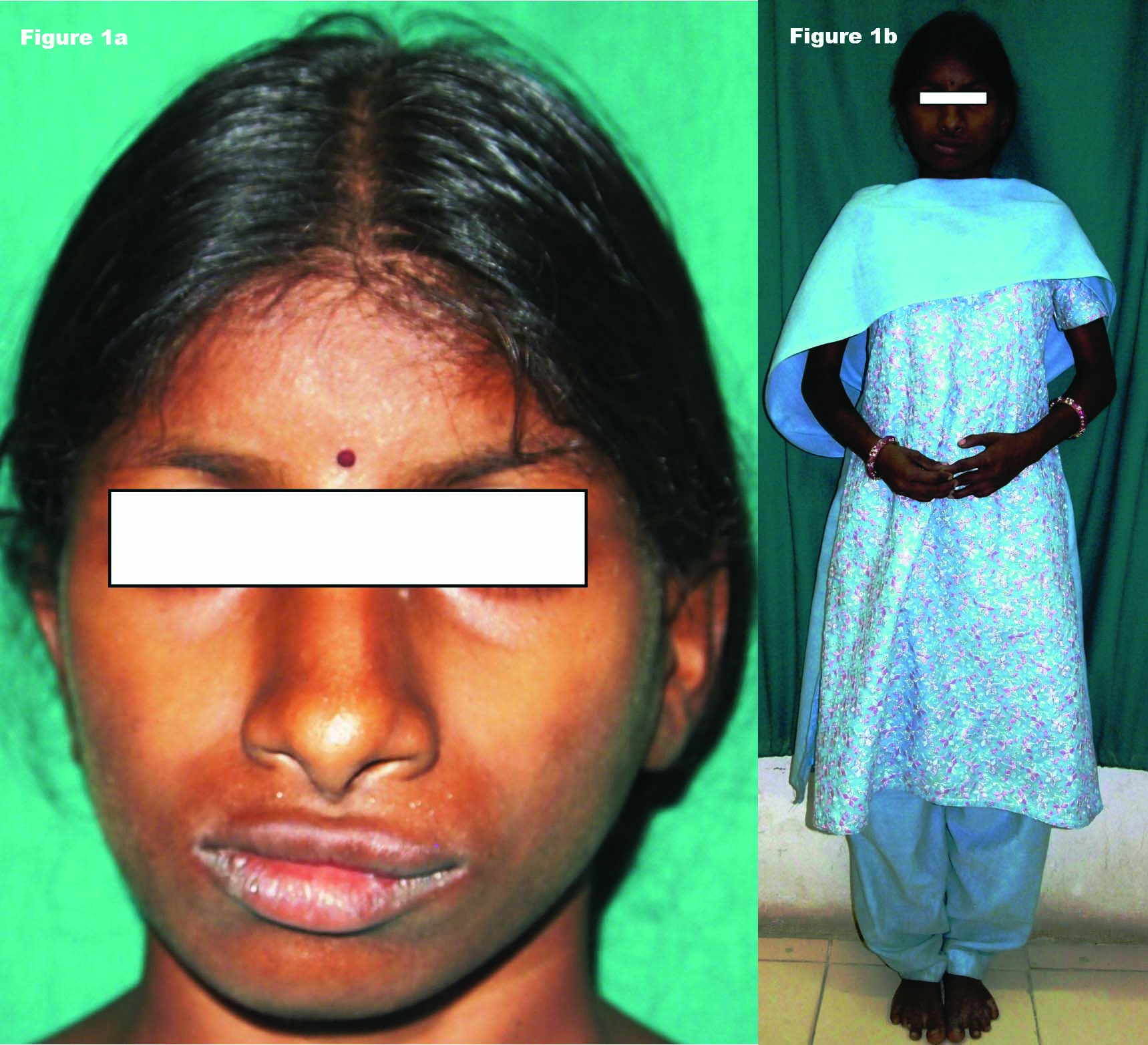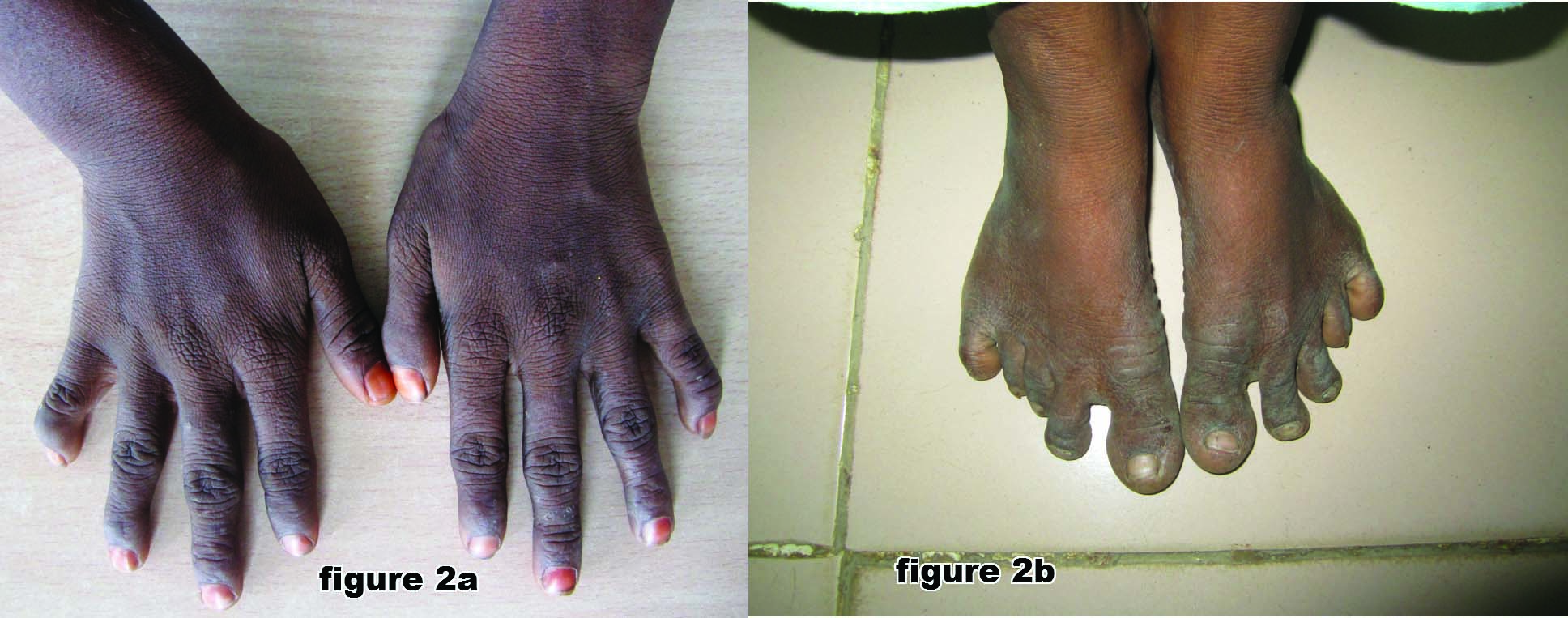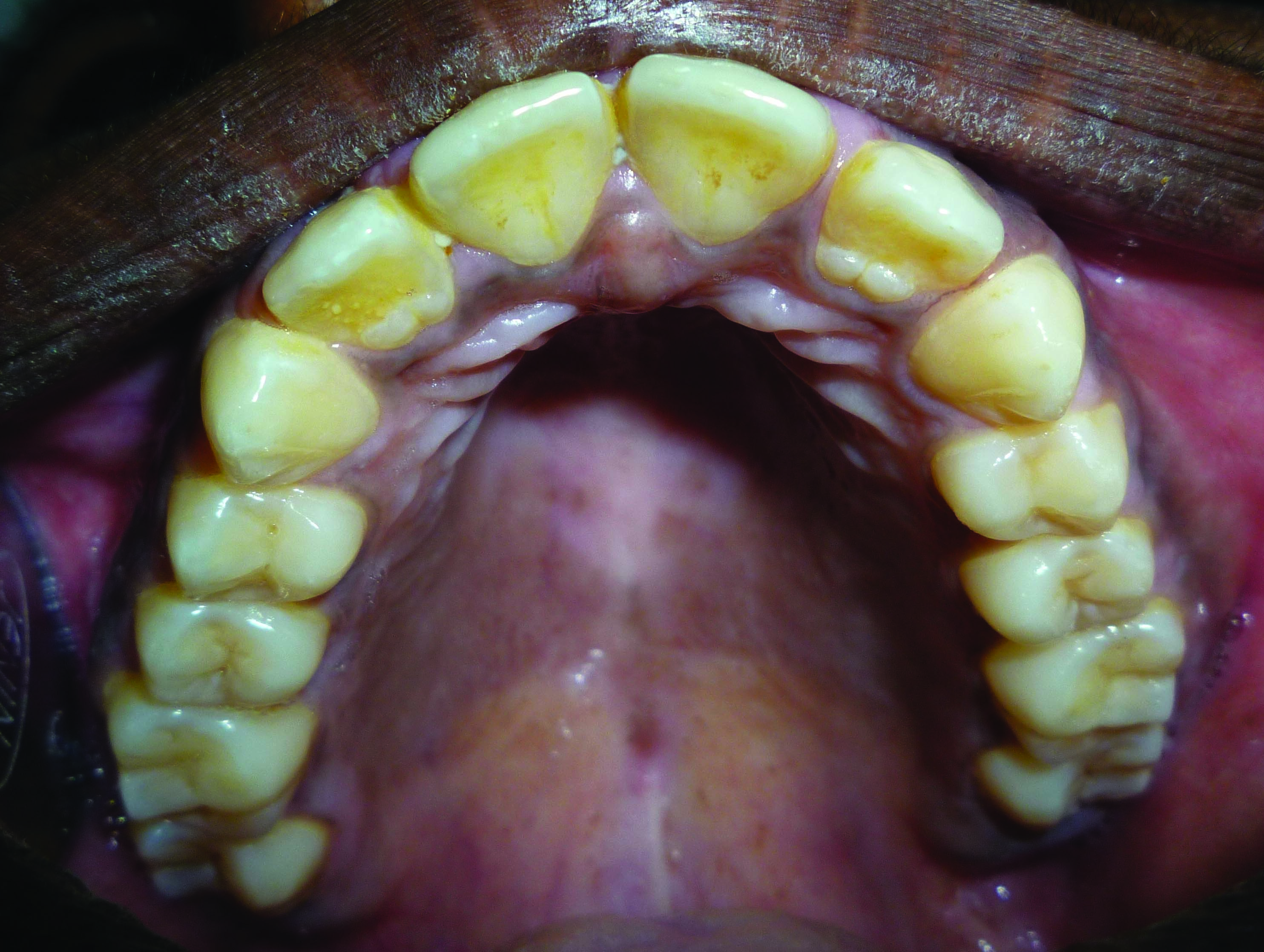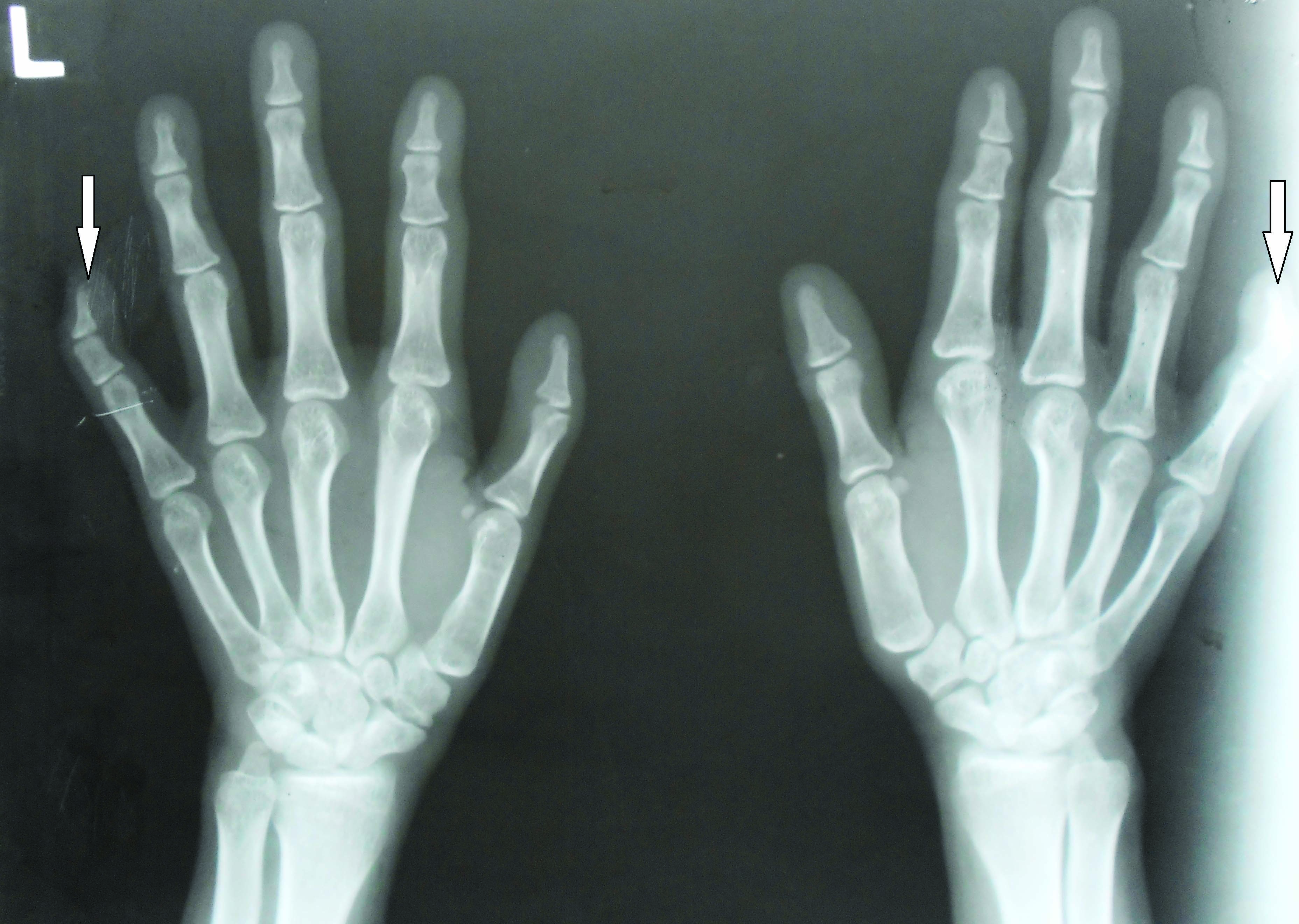Broad Thumb-Hallux Syndrome: A Diagnosis Made on Clinical Findings
D. Angeline Deepthi1, V. S Shaheen2, M. Hari Kumar3, Sajna Ashraf4, John Hearty Deepak5
1 Reader, Department of Oral Medicine and Radiology, Rajas Dental College, MGR Medical University, Kavalkinaru Junction, Tirunelvelli, India.
2 Assistant Professor, Department of Orthodontics, King Khalid University College of DentistryAbha, Saudi Arabia.
3 Senior Lecturer, Department of Oral Medicine and Radiology, Saveetha Dental College and Hospital, Saveetha University, Chennai, Tamil Nadu, India.
4 Lecturer, Department of Oral Medicine and Diagnostics, Al Farabi College of Dentistry, Riyadh, Saudi Arabia.
5 Senior Lecturer, Department of Oral Medicine and Radiology, Rajas Dental College (Under the M.G.R Medical University), Kavalkinaru Junction, Tirunelvelli, India.
NAME, ADDRESS, E-MAIL ID OF THE CORRESPONDING AUTHOR: Dr. M Hari Kumar, Senior Lecturer, Department of Oral Medicine and Radiology, Saveetha Dental College and Hospital, Saveetha University, Chennai-600077, Tamil Nadu, India.
E-mail: drhari.omrd@gmail.com
Rubinstein-Taybi syndrome,Clinodactyly,Talon cusps
An 18-year-old female visited our dental clinic for routine dental checkup. Her medical history was suggestive of low birth weight, delayed milestones. Echocardiography, abdominal ultrasonography and fundus examination of the eyes were normal. Past dental history revealed delayed eruption of primary and permanent tooth. Extra oral examination revealed microcephaly, hypertelorism, broad nasal bridge with the nasal septum extending below the alae nasi [Table/Fig-1a]. She was 122 cm in height [Table/Fig-1b]. She was also noted to have bilateral clinodactyly of fifth fingers of hand with broad thumbs and also had brachydactyly of both feet with broad great toes [Table/Fig-2a&b]. Intraoral examination revealed poor oral hygiene with a high arched palate. Talons cusps were present on the right and left maxillary lateral incisor [Table/Fig-3]. Psychometry revealed low IQ (65). Hand wrist radiograph revealed clinodactyly of fifth finger of right and left hand [Table/Fig-4].
a) Broad nasal bridge with the nasal septum extending below the alae nasi; b) Short stature of the patient.

a) Clinodactyly of fifth fingers of both hand with broad right and left thumb; b) Brachydactyly of both feet.

Talons cusps in the right and left maxillary lateral incisor.

Clinodactyly of fifth finger of right and left hand shown by black arrow in the hand wrist radiograph.

Due to patient’s poor economic status and the regional unavailability of genetic test for CREBBP and EP300 genes mutation, the authors were unable to procure genetic analysis for this patient. Thus, based on the available clinical findings and investigation the patient was diagnosed as having broad thumb-hallux syndrome. In this case comprehensive dental treatment could not be planned under sedation or general anesthesia due to the reluctance of the parents for the procedure. The parents were advised to have regular recall visits.
Rubinstein-Taybi Syndrome (RSTS) or broad thumb-hallux syndrome is a sporadic congenital mental retardation syndrome. Individuals with RSTS have noticeable clinical features which include postnatal growth deficiency with typical dysmorphic facial features. Broad thumbs with broad great toes are present in almost all RSTS cases. In India prevalence of RSTS is 1 in 100,000 to 125,000 [1]. Worldwide prevalence of RSTS is approximately one in every 125,000 newborns [2,3].
RSTS is a rare autosomal dominant disorder characterized by short stature, dysmorphic facial features with prominent forehead, arched eyebrows, slanted palpebral fissures, grimacing or atypical smile, microcephaly, broad thumbs and first toes. Congenital cardiovascular abnormalities of RSTS include ventricular septal defect, patent ductus arteriosus, coarctation of aorta. Additional abnormalities are lacrimal duct obstructions, glaucoma with obstructive sleep apnea. Clinodactyly of fifth fingers and beaked nose with the nasal septum extending below the alae are present in over half the reported cases. There are no standard international guidelines and diagnostic criterion available for diagnosing RSTS [2].
Broad thumb-hallux syndrome is characterized by a variety of orofacial features including limited mouth opening, micrognathia with pouting lower lip, crowding, high arched and narrow palate. Individuals with RSTS have striking oral features including talon cusps, hypodontia with enamel hypoplasia [3].
Kumar S et al., concluded from his retrospective study that RSTS is an archetypical syndrome with multiple congenital malformations. The clinical management for most RSTS cases mainly depends on a multidisciplinary approach. A prior diagnosis of RSTS with medical genetics team counseling helps in better treatment planning and management [1].
Mutations in the genes encoding the Cyclic-AMP-Regulated Enhancer Binding Protein (CREBBP) in chromosomal region 16p13.3 and the E1A-binding protein p300 (EP300) in chromosomal region 22 have been associated with approximately half of RSTS patients. Although, genetic tests act as key tool in diagnosing RSTS, majority of reported RSTS cases are diagnosed based on clinical findings [2]. Majority of RSTS patient require sedation or general anaesthesia for dental treatment. In most RSTS cases dental treatment cannot be performed in routine dental set up due to mental disability to cope with routine dental procedures [3].
[1]. Kumar S, Suthar R, Panigrahi I, Marwaha RK, Rubinstein taybi syndrome: Clinical profile of 11 patients and review of literature Indian J Hum Genet 2012 18:161-66. [Google Scholar]
[2]. Milani D, Manzoni F, Pezzani L, Ajmone P, Gervasini C, Menni F, Rubinstein-Taybi syndrome: clinical features, genetic basis, diagnosis, and management Ital J Pediatr 2015 41:4 [Google Scholar]
[3]. Munevveroglu AP, Akgol BB, Rubinstein-Taybi syndrome: a case report Case Reports in Dentistry 2012 2012:483867 [Google Scholar]